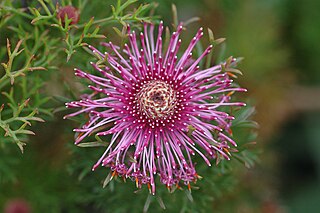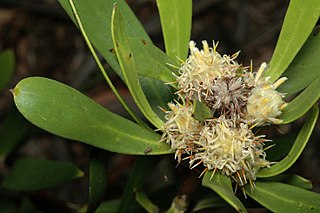
Isopogon, commonly known as conesticks, conebushes or coneflowers, is a genus of about forty species of flowering plants in the family Proteaceae, and are endemic to Australia. They are shrubs with rigid leaves, bisexual flowers in a dense spike or "cone" and the fruit is a small, hairy nut.

Isopogon formosus, commonly known as rose coneflower, is a species of flowering plant in the family Proteaceae and is endemic to the south-west of Western Australia. It is a shrub with divided leaves with cylindrical segments, and spherical to oval heads of pink or red flowers.

Isopogon cuneatus, commonly known as coneflower, is a species of plant in the family Proteaceae and is endemic to the south-west of Western Australia. It is a shrub with oblong to egg-shaped leaves with the narrower end towards the base, and flattened-spherical heads of glabrous pale to purplish pink flowers.

Banksia armata, commonly known as prickly dryandra, is a species of often sprawling shrub that is endemic to Western Australia. It has deeply serrated leaves with sharply pointed lobes and spikes of about 45 to 70 yellow flowers.
Banksia tortifolia is a small, spreading, prostrate shrub that is endemic to the southwest of Western Australia. It has short underground stems, pinnatipartite leaves with sharply-pointed, linear lobes on each side, greenish-cream, yellow and pink flowers in heads of about eighty, and glabrous, egg-shaped follicles.

Isopogon sphaerocephalus, commonly known as drumstick isopogon or Lesueur isopogon, is a species of plant in the family Proteaceae and is endemic to the south-west of Western Australia. It is a shrub with linear to narrow egg-shaped leaves and spherical heads of hairy white to creamy yellow flowers.

Isopogon adenanthoides, commonly known as the spider coneflower, is species of flowering plant in the family Proteaceae and is endemic to the southwest of Western Australia. It is an erect shrub with sharply-pointed, trifid leaves and spherical heads of pink flowers.

Isopogon attenuatus is a species of plant in the family Proteaceae and is endemic to the south-west of Western Australia. It is a shrub with oblong to spatula-shaped or linear leaves and spherical heads of yellow flowers.

Isopogon baxteri, commonly known as the Stirling Range coneflower, is a species of plant in the family Proteaceae and is endemic to the south-west of Western Australia. It is an erect shrub with wedge-shaped, often 3-lobed, toothed leaves and flattened spherical heads of hairy pink flowers.

Isopogon divergens, commonly known as spreading coneflower, is a species of plant in the family Proteaceae and is endemic to the south-west of Western Australia. It is a shrub with pinnate leaves and more or less spherical heads of glabrous pink flowers followed by an oval to cylindrical fruiting cone.

Isopogon spathulatus is a species of flowering plant in the family Proteaceae and is endemic to south-western Western Australia. It is a shrub with linear to egg-shaped leaves with the narrower end towards the base, and more or less spherical heads of hairy pink flowers.

Isopogon polycephalus, commonly known as clustered coneflower, is a species of plant in the family Proteaceae and is endemic to the South coast of Western Australia. It is a spreading shrub with linear to lance-shaped leaves with the narrower end towards the base, and clusters of more or less spherical heads of white, cream-coloured or yellow flowers.

Grevillea eryngioides, commonly called curly grevillea, is a species of flowering plant in the family Proteaceae and is endemic to the south-west of Western Australia. It is shrub with low clumping foliage with erect flowering spikes, divided leaves with oblong to egg-shaped lobes, and groups of purplish-red flowers with a yellow style.

Isopogon crithmifolius is a species of plant in the family Proteaceae and is endemic to the south-west of Western Australia. It is a shrub with divided leaves and more or less spherical heads of glabrous reddish pink flowers.

Isopogon scabriusculus is a species of flowering plant in the family Proteaceae and is endemic to southwestern Western Australia. It is a shrub with cylindrical, or narrow flat, sometimes forked leaves, and spherical to oval heads of pink or red flowers.

Isopogon tridens, commonly known as the three-toothed coneflower, is a species of flowering plant in the family Proteaceae and is endemic to the southwest of Western Australia. It is a shrub with wedge-shaped leaves with two or three sharply-pointed teeth, and flattened-spherical heads of glabrous creamy white, sometimes purple flowers.

Asterolasia grandiflora is a species of weak, open shrub or sub-shrub that is endemic to the southwest of Western Australia. It has oblong, elliptical or egg-shaped leaves and pink to mauve flowers arranged in umbels of about three flowers with a thick covering of star-shaped hairs on the back of the petals.
Diplolaena drummondii is an endemic Australian flowering plant in the family Rutaceae. It is only found in Western Australia. It is a small, spreading shrub with oblong to elliptic papery, thin leaves, and yellow, orange or reddish flowers which bloom between July and November.
Isopogon robustus, commonly known as robust coneflower, is a plant in the family Proteaceae and is endemic to a restricted area in the southwest of Western Australia. It is a shrub with cylindrical leaves and oval heads of pink flowers.

Goodenia sepalosa is a species of flowering plant in the family Goodeniaceae and is endemic to northern Australia. It is a prostrate to ascending herb with narrow oblong to lance-shaped leaves, the narrower end towards the base, and racemes of yellow flowers.

















